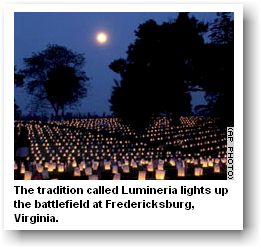Civil War Re-enactments Foster Tourism
(CNN.com,
12 November 2004)
RICHMOND, Virginia (AP) -- From
Spotsylvania to Shiloh, Civil War enthusiasts continue to re-enact clashes from
the conflict fought nearly 150 years ago, traveling to battlefields with
their weapons, uniforms and passion for history.
Now instead of just allowing
re-enactors places to stage their skirmishes, local and state officials
are starting to underwrite the events, recognizing that
their investment can pay big dividends.
"In one word, it's
tourism," said Jim Campi, policy director for the Civil War preservation Trust. "It's taken
awhile but local and state officials have come to realize that Civil War battlefields and battlefield
preservation can mean big bucks for
their community."
The Washington group refers to
battlefields as low-impact economic engines because tourists who visit spend their dollars on things like gasoline,
lodging and restaurant meals.
"They don't need the police and
fire departments. They aren't trying to put their kids though county schools," Campi said. "These are the
kind of persons localities want
to attract."
A Civil War Preservation Trust study
found that tourists at seven battlefields
it studied (including Gettysburg in Pennsylvania, Shiloh in Tennessee, and Virginia's New Market and
Fredericksburg/Spotsylvania sites) generated
nearly $157 million in total visitor expenditures last year, and $22.4 million in local and state tax
revenues.
Civil War sites are the destinations
of about 11.5 percent of visits to history-rich
Virginia, according to a 2003 state tourism study.
State tourism officials are
"delighted to see preservation groups seeing tourism as economic development, something
we've obviously advocated for many
years," Virginia Tourism Corp. director Martha Steger said.
'Good economic development'
This May, Spotsylvania County spent
$250,000 for the restaging of the bloody Battle of Spotsylvania Court House.
The two weeks of fighting between the troops of Gen. Ulysses S. Grant and Gen. Robert E. Lee in May 1864 left
about 18,000 Union soldiers and about
12,000 Confederates killed, wounded or missing.
The three-day event drew 4,000
re-enactors and 10,000 paying spectators to the area, said Henry "Hap" Connors Jr., vice chairman of the
county's board of supervisors.
Doug Barnes, deputy county
administrator, said the re-enactment cost $40,000 more than it took in, but sales and meals
taxes and merchandise sales have yet
to be fully measured. Also, he said, the re-enactment was "more of a
future marketing tool," which has translated
into visitors' increased interest
in the area.
"We are trying to show people
that preservation and heritage tourism make for good economic development," Connors said. "We don't need
to pave over battlefields to put
big-box stores on them -- we need to instead look at these historic and cultural treasures as
opportunities to create new economic-development
opportunities."
The first-time county sponsorship
was a prelude to other events, including plans to commemorate the battle's sesquicentennial in 2014, Connors
said.
Connors sees historical preservation
as a way to stem sprawl, but added that he and other slow-growth advocates aren't necessarily at odds with
developers.
"I'm not opposed to anybody
making money, but we are starting to let them know what we want," he said. "We're starting to negotiate
from a position of strength. We
have tools available to manage this growth and we're starting to use them."
In Kentucky, state officials
budgeted $10,000 to host the Battle of Perryville reenactment on October 9-10, said Kurt Holman, manager of
the Perryville Battlefield
historical site.
"Port-a-johns are the biggest
single bite," Holman said. Musicians, hay for tents and horses, and overtime and lodging
for park rangers also were among the
expenses.
About 5,900 spectators attended and
800 re-enactors came to Perryville this year, up from about 4,700 last year, state park officials said. Each
overnight guest spends nearly $91 in
the area; a day visitor about $39, according
to Kay Berggren, executive director of the local Convention and Visitors Bureau.
Perryville re-enactors also pay a
registration fee, but Holman said that money goes directly to the Perryville Battlefield Preservation
Association.
The battle for 'heritage
tourists'
 Campi said many government officials
are starting to realize that "when you preserve a significant portion of the battlefield, people will come and
see it. There's been a real
upsurge in visits to historic sites like battlefields."
Campi said many government officials
are starting to realize that "when you preserve a significant portion of the battlefield, people will come and
see it. There's been a real
upsurge in visits to historic sites like battlefields."
Such "heritage tourists"
tend to have more money and are willing to spend it, he said. Many of them are retirement age, and have the time to stay
in the community for more than a
day.
But the key to preserving history
for future generations is making the Civil War relevant or "cool" to young people, said Rob Hodge, a
re-enactor and co-founder of
Wide Awake Films, which coordinated Spotsylvania's event in May and produces Civil War footage.
"You have to get to the
children when you're talking about such a significant event. Even if it's 140 years old you have to look at why
it resonates in the 21st
century," Hodge said.
The question is "How do you
make it viable -- how do you make it a competitor to the addiction to sports or the addiction to survival
shows?" he said.
"Cutting-edge technology might be the savior of the past."
One proposal is to offer wireless
Internet access on battlefields, where visitors can download and view imagery and information onto their
laptop computers while they
stand where troops once clashed.
"We're competing against action
movies," he said. "But the great American screenplay is the Civil War. The great
American horror is the Civil War."
The nation suffers from "a great cultural amnesia," Hodge said. "It's our job, our mission, to try to breathe life into some of these things that collect dust."
